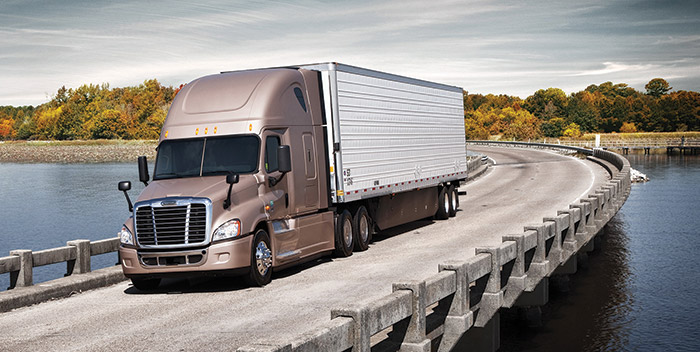Reducing operating costs
“Improving safety at a fleet does a great deal to help reduce costs,” Andersky said. “If the safety system can help a fleet move over, and reduce what would have been a fatality crash to a property damage only crash—or better yet, a near miss—this means savings directly to the bottom line, especially if the fleet is self-insured. It can also help improve the fleet’s risk profile, which may result in lower insurance costs.”
Training for both drivers and technicians is also an important way to help fleets reduce operating expenses. Training drivers on safety systems helps the driver to better understand the capabilities of the safety technology and what to expect on the road. This is important because training on the system helps the driver understand the upper thresholds of performance of the safety system and not to test the system. Even with safety technologies in place, drivers should always in control of their vehicle and should keep their focus on driving in a safe, normal, prudent manner.
“It’s always important to remember that driver assistance systems are not driver replacement systems,” Andersky continued. “The driver is still responsible for the control and safe operation of his or her vehicle at all times. The Bendix Wingman Advanced and Bendix Wingman Fusion systems—like all Bendix safety technologies—complement safe driving practices and are not intended to enable or encourage aggressive driving. No commercial vehicle safety technology replaces a skilled, alert driver exercising safe driving techniques and proactive, comprehensive driver training.”
While studies show that most heavy truck and light vehicle crashes are caused by the light vehicle driver—71% according to the 2006 Large Truck Crash Causation Study—safety systems can help fleets and drivers mitigate these situations. In today’s CSA environment, where both the livelihood of the driver and the fleet can be impacted by crashes, it’s important that fleets take advantage of every opportunity to help reduce the possibility of a crash.
Warning and response
“OnGuardACTIVE, which is a radar-based active safety system, offers collision warning, collision mitigation braking and ACC, even in limited visibility situations,” explained Meritor WABCO’s Stevenson. “The system is able to distinguish between moving, stationary, and stopped vehicles, and will alert or brake on all three. OnGuardACTIVE evaluates those vehicles forward of the truck, determining threats by measuring vehicle relative position, range rate, and bearing rate. Once a threat has been identified, OnGuardACTIVE employs a three-tiered strategy. First, it provides a visual and audible warning to the driver to give the driver a chance to intervene. Second, if no action is taken and the collision event becomes more likely, a haptic alert is given to the driver. Third, if no driver action is taken, the system engages in active collision mitigation braking.”
A new feature of the OnGuardACTIVE system is collision mitigation braking on completely stationary vehicles. Stationary vehicles are vehicles that the radar has never seen move and represent about 20% of all rear end crashes. The ACC portion of the system maintains the truck’s set speed while in cruise control mode when the lane ahead is clear, and will automatically adjust the truck’s speed to maintain a safe following distance when a slower moving vehicle ahead is detected.
Benefits of an integrated suite
 Primarily, the benefit of an integrated suite of safety systems is the additional improvement of the safety system efficacy and the increased mitigation or elimination of as many accidents as possible, as well as reduction in overall system cost. Integrated safety systems take advantage of the sensor data from each system for cross correlation, gaining multisystem synergy and providing an additional improvement in total cost of ownership.
Primarily, the benefit of an integrated suite of safety systems is the additional improvement of the safety system efficacy and the increased mitigation or elimination of as many accidents as possible, as well as reduction in overall system cost. Integrated safety systems take advantage of the sensor data from each system for cross correlation, gaining multisystem synergy and providing an additional improvement in total cost of ownership.
“Having these systems integrated allows for less vehicle downtime, collision-related costs and property damage expenses while helping with increased fuel efficiency. Integration also allows for a smoother system diagnosis through products like Meritor WABCO Toolbox diagnostic tool,” Stevenson said.
Though these are individual systems, they function as an integrated unit, which is important to ensure the highest safety benefit is achieved. “ABS, ESC and OnGuard Collision Mitigation function seamlessly with one another,” Stevenson said. “If during a collision mitigation-braking event, a wheel starts to rapidly decelerate to a lock condition, the ABS will detect this and automatically reduce pressure in the affected wheel to prevent a locking situation from developing. If a slight loss of stability occurs during a collision mitigation-braking event, the ESC will automatically activate and generate a counter-active force to regain stability. The driver’s perception will be one system is at work ensuring stability and reducing the likelihood of a rear end crash.”
Video analytics also make up an important piece of the integration story. With these safety systems installed on the vehicle, there is a tremendous amount of information regarding how the vehicle is being driven and performing. Video analytic systems are capable of gathering this data and providing fleets actionable information on how to drive improvement.
“When critical events occur, these analytic systems can determine the true root cause and more times than not, it is not the responsibility of the truck driver,” Stevenson explained. “The new OnLane Lane Departure Warning System will provide the forward looking video input to SmartDrive’s fleet management performance system.”
Return on Investment
Driver training is necessary to achieve the biggest payback from these advanced driver assistance safety systems. According to Stevenson, there are three important aspects of driver training:
- Drivers must understand how, why and when the system activates. These systems are designed to assist drivers and make them safer drivers. Stevenson has heard from many drivers who have never experienced a rollover and do not understand why the stability control system occasionally activates when they are in a curve. What they might often fail to realize, he says, is how close to a rollover incident the driver was. Understanding system functionality will lead to taking turns more slowly, further reducing the rollover risk.
- Communicating the fleet reduction in accident rate is imperative. Fleets report dramatic reductions in crashes, and yet the drivers often are left out of the “feel good” message. The reality of crash reductions mean fewer fatal, injury and property damage crashes. Positive communications to the driver on the real-world results of these integrated safety systems will help drivers to better understand their value and embrace their performance.
- Video analytic systems can give a clear picture of how vehicles are being driven, show the actions of surrounding vehicles, and provide recommendations on how driving characteristics can be altered to further improve safety, provide driver exoneration, but improve fuel economy as well.
“OnGuard is part of an ongoing evolution of Meritor WABCO safety systems whose goal is to eliminate all large truck serious crashes,” Stevenson added. “The data shows progress being made. Between 2005 and 2014, the large truck fatal crash rate has decreased by 40%, but there is still room for improvement. Meritor WABCO continues to strive for higher performance levels from our existing safety systems and will release new ones capable of addressing other types of crashes. We are actively investigating higher levels of automation for large trucks, with the goal being to further reduce the crash risk and make the driving experience more efficient. As part of our annual OnGuard Fleet Advisory Council, fleets have shared with us the impact systems like OnGuard and SmartTrac Stability Control Systems have had. It has been reported that rear-end collisions have in some cases been reduced by up to 87%, and the costs associated with rear-end collisions have been reduced by up to 89%.”















